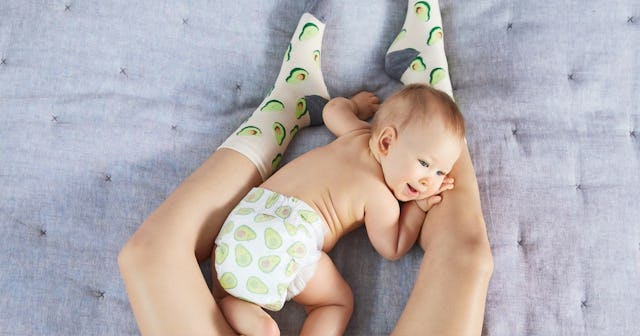Do Babies Have Kneecaps?

Check out more from our Baby & Toddler Development package to read more about thrush in babies, jaundice, baby hiccups, why babies look bow legged, toddler flat feet, newborn eye color, and bone structure in babies.
When you’re pregnant, you learn a lot of weird facts about babies. Like, things that you scoff at — things that can’t possibly be true… can they? Well, they can, and one of those things is the truth about babies’ kneecaps. If your Google searches have veered in the “does my baby have kneecaps” territory lately, you’re not alone. According to recent search data, that question is searched more than 18,000 times per month. You may have heard babies are born without kneecaps, which sounds like a bunch of hullabaloo. How would that even work, right? Sit tight, because what you’re about to discover will blow your mind a little.
Are babies really born without kneecaps, or patellae?
Are you ready for this? It’s a scientifically-backed truth that babies are born without kneecaps. Sort of. Okay, to clarify, this question could be answered a few different ways. In the technical sense, babies are not born with the same kind of kneecaps that adults have. By that logic, no, newborns don’t come out with kneecaps. Having said that, babies are born with a type of kneecap — it just isn’t made up of solid bone like mine or yours. Theirs are comprised mainly of cartilage, hence it is referred to as the cartilage patella at birth.
So, whether you classify what a baby is born with as a kneecap depends on how you view the definition. The idea that babies definitively do not have kneecaps when they’re born may come from the fact that a newborn’s kneecaps can barely be seen in an x-ray, as they’re not made up of solid bone.
Why are babies born without “kneecaps”?
Moms may have evolution to thank for babies being born without solid bone kneecaps. You see, bone is obviously rigid. The kneecaps, in particular, can be sharp, angular, and generally less conducive to moving through the birth canal without issue. So, the theory goes that kneecaps begin as cartilage because cartilage is more pliable than bone.
Plus, having cartilage patellae is beneficial to baby as they grow and develop. Your little one is going to have to learn to navigate the great big world they now inhabit, and that means crawling around, cruising while holding onto tables and, eventually, figuring out that whole walking thing. All of these things mean baby’s kneecaps will be making lots of contact with the ground (or other hard surfaces), so having more cartilage than bone in those early years offers more flexibility.
At what age does a baby develop kneecaps?
You’re probably looking at your baby’s knees right now — or your own — and wondering when newborn “kneecaps” turn to bone. According to Dr. Eric W. Edmonds of Rady Children’s Hospital in San Diego, the hardening (or ossification) of cartilage patella into bone begins somewhere between the ages of two and six.
Often, the cartilaginous kneecap starts to harden at multiple centers, ultimately fusing together over several years. This process takes place gradually but, typically, the kneecap will have fully developed into a bone between the ages of 10 to 12. Still, a small portion of the kneecaps remains cartilaginous and a deposit of fatty tissue called a fat pad offers extra cushion for all that play without taking a toll on the newly formed kneecaps.
Can anything go wrong during this process?
In a word, yes. One potential issue is bipartite patella, which happens when the hardened sites of cartilage form two separate pieces of bone instead of fusing into one. A child with this condition could be asymptomatic, but they may also experience pain. Treatments include non-operative, symptomatic pain management and physical therapy for the bipartite patella for at least six months. These include abstaining from sports activity, increased rest, and strengthening exercises, among other measures.
Another possibly painful kneecap complication is Osgood-Schlatter disease. With this condition, which is most common among young athletes, the patellar tendon attaches to the top of the shinbone. In some cases, it can cause extra bone growth at the site of the tendon attachment, leading to permanent bumps just below the kneecaps.
Just because your toddler or young child hasn’t fully developed hardened bones where his kneecaps are doesn’t mean they are not prone to injuries. Falling, overuse, and bruising can still happen if you have an active child who participates in sports or just loves to horse around and be a kid on the playground. If your child complains of pain or if there is swelling, see your pediatrician who can direct you to the correct next expert.
While it’s good to be aware of these possibilities, don’t let them keep you up at night. More often than not, the cartilaginous kneecaps a baby is born with eventually develop into a bone kneecap without incident.
Do babies need kneepads when they start crawling?
The quick answer to this is no. Crawling on their knees all day doesn’t hurt babies the way it hurts the mama crawling right next to her tot. That’s because the cartilage and the adorable dimpled fat deposits around their knees protect them from injury. Some parents do buy those foam mats to make it easier on them, however, but as experienced moms know, you’re not keeping a crawling baby in a rectangle perimeter for long.
Additionally, some parents buy little knit kneepads to protect the skin around their knees from irritation, but truthfully, you can just keep them in a pair of leggings and it’ll do the same thing.
This article was originally published on